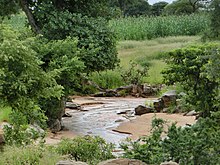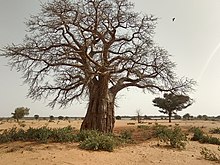Wildlife of Sudan

Thewildlife of Sudanis composed of itsfloraandfauna.A variety of climate types inSudanresults in a wide range of habitats and the range of wildlife is diverse. Some 287 species of mammal have been recorded in the country and some 634 species of bird.
Geography[edit]
Sudan is located in northeastern Africa, with an 853 km (530 mi) coastline bordering on theRed Sea.The terrain is generally flat, with low-lying plains broken by a few mountain ranges. In the west, theMarrah Mountainsare the highest part of Sudan, while in the east lie theRed Sea Hills.TheBlue Nileand theWhite Nileconverge atKhartoumto form theNile,which flows northwards to theMediterranean Sea.[1]The climate ranges from hyper-arid in the north of the country to tropical wet-and-dry in the south. Variations in the length of the wet and dry seasons depend on which of two air flows predominates: dry northern winds from the Sahara and the Arabian Peninsula or moist southwesterly winds from the Congo River basin and southeasterly winds from the Indian Ocean. The wet season in the north occurs between June and September while it arrives earlier and lasts longer in the south. The temperature is high all year round, with the hottest weather occurring at the end of the dry season.[2]
Flora[edit]

The northern part of the country is largely desert with very little vegetation except beside watercourses. In more central parts, the semidesert receives rather more precipitation and supportsAcaciascrub and various grasses. With the increased rainfall further south this merges intosavannahwith grasses, thorny trees and largerbaobabtrees. These are dominated by Acacia trees, including theSudan gum(Acacia senegal) which yieldsgum arabic,historically one of the mainstays of the country's export trade.[3]The Nile basin in the south receives more rainfall, and the grass is lush, providing grazing for herds of cattle. There are also patches of woodland here.[3]
A characteristic tree which grows in woodland and beside seasonal water-courses in the Marrah Mountains is the winter thorn (Faidherbia albida). Cattle stand in its shade in the dry season eating shed leaves and fruits, andsorghumcrops do well underneath it in the rainy season.[4]An important species in arid and semi-arid regions is the umbrella thorn acacia (Vachellia tortilis).[5]
TheSuddwetlands are a vast area of swamp in the south beside the White Nile. Here beds of reeds are interspersed by areas of aquatic vegetation includingwater hyacinthandpapyrus,grasses and scrub.[6]
Fauna[edit]

Most of the 287 or so species of mammal found in Sudan are small and nocturnal, beingrodents,batsandinsectivores.Elephant shrewsalso occur, and among the larger mammals are thecrested porcupineand therock hyrax.[7] Big cats found in Sudan includelions,leopardsandcheetahs.[3]There are many species ofantelopeas well asgiraffes,rhinocerosesandelephants,andmonkeysare found in forested areas.[3]
Reptiles are abundant but mostly small and inconspicuous. Snakes are numerous and include theAfrican rock python,theblack mamba,theEgyptian cobra,theforest cobra,theblack-necked spitting cobra,theboomslangand thepuff adder.[7]Crocodiles are found near the Nile and other water bodies and there are many species of lizard, the largest being theNile monitor.TheAfrican spurred tortoiseand theleopard tortoiseoccur in arid areas and several aquatic species ofterrapin,such as theAfrican helmeted turtle,occur in swamps and marshes.[7]
Among the 19 genera of amphibians found in Sudan there is one endemic species of frog.[8]
634 species of bird have been recorded in Sudan.[9]These include waterfowl and wading birds, raptors, game birds, seabirds, songbirds, swifts, cuckoos and nighthawks. Some are resident species, present all year round, or breeding birds that rear their young in the country. Others are over-wintering birds, avoiding harsher weather conditions elsewhere, or migrant species that are just passing through.[10]TheKordofan sparrow(Passer cordofanicus) isendemicto Sudan andSouth Sudan.[9]
Insects are abundant in great variety andtsetse fliesoccur south of latitude 12° north.[3]
Protection[edit]
The main legislation governing wildlife is the Preservation of Wild Animals Act of 1935. This regulates hunting and trade and lists protected species.[11]Game and wildlife tourism includes hunting forEritrean gazelles,Nubian ibexandbaboonsin the area between the Nubian Desert and the Red Sea Hills. In the Western Desert,Barbary sheep,Arabian oryx,ostrichesandred-fronted gazellesare also hunted, as well as ducks,guineafowl,bustardsanddoves.Overhunting, loss of habitat, and a lack of enforcement of regulations has led to a decline in populations and biodiversity. In 2015, the United Nations reported that 123 species in the country were listed as "threatened".[12]
Among several protected areas in Sudan areRadom National ParkinSouth Darfur,in the southwest of the country, andDinder National Parkin the southeast, both of which areUNESCO biosphere reserves.There are also a number of game reserves.[3]TheSuakin Archipelago National Parkis a cluster of islands off the coast in the Red Sea and is amarine protected areaof 579 square miles.[6]These islets are fringed by coral reefs, being visited by four species ofturtleand home to five species of breeding bird.[12]
References[edit]
- ^Philip's Atlas of the World.Reed International. 1994. pp. 94–95.ISBN0-540-05831-9.
- ^
 This article incorporates text from this source, which is in thepublic domain:Bechtold, Peter K. (2015)."Climate"(PDF).In Berry, LaVerle (ed.).Sudan: a country study(5th ed.). Washington, D.C.:Federal Research Division,Library of Congress.pp. 70–71.ISBN978-0-8444-0750-0.
This article incorporates text from this source, which is in thepublic domain:Bechtold, Peter K. (2015)."Climate"(PDF).In Berry, LaVerle (ed.).Sudan: a country study(5th ed.). Washington, D.C.:Federal Research Division,Library of Congress.pp. 70–71.ISBN978-0-8444-0750-0.
- ^abcdef"Sudan: Plant and animal life".Britannica.Britannica.Retrieved26 February2023.
- ^Radwanski, S.A.; Wickens, G. E. (1967). "The Ecology ofAcacia albidaon Mantle Soils in Zalingei, Jebel Marra, Sudan ".Journal of Applied Ecology.4(2): 569–579.doi:10.2307/2401358.JSTOR2401358.
- ^Kennenni, Legesse; van der Maarel, Eddy (1990). "Population ecology ofAcacia tortilisin the semi-arid region of the Sudan ".Journal of Vegetation Science.1(3): 419–424.doi:10.2307/3235719.JSTOR3235719.
- ^ab"Sudan's Top National Parks".WorldAtlas. 25 April 2017.Retrieved26 February2022.
- ^abcLovell-Hoare, Max; Lovell-Hoare, Sophie (2013).South Sudan.Bradt Travel Guide. pp. 39–40.ISBN9781841624662.
- ^Duellman, William E. (1999).Patterns of Distribution of Amphibians: A Global Perspective.JHU Press. pp. 497, 504.ISBN9780801861154.
- ^ab"Avibase".2020.Retrieved24 February2023.
- ^"Birds of Sudan".2020.Retrieved24 February2023.
- ^de Klemm, Cyrille; Lausche, Barbara J. (1987).African Wildlife Laws.IUCN. p. 224.ISBN9782880320911.
- ^abLevy, Patricia; Latif, Zawiah Abdul; Young-Brown, Fiona (2017).Sudan.Cavendish Square Publishing. pp. 52–60.ISBN9781502626110.
External links[edit]
 Media related toWildlife of Sudanat Wikimedia Commons
Media related toWildlife of Sudanat Wikimedia Commons
